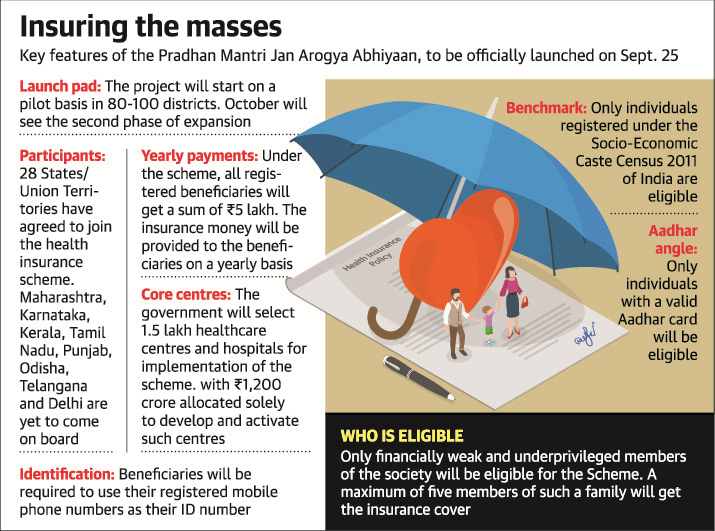PMJAA
- The government-sponsored health insurance scheme will provide free treatment for up to Rs.5 lakh a family a year in any government or empanelled private hospitals all over India.
- Meant to help the poor and the economically deprived, the scheme will be available for 10.74 crore beneficiary families and about 50 crore Indian citizens.
- Read more details in Ayushman Bharat in Prelims Section.
Significance
- Ayushman Bharat is an attempt to ensure that universal healthcare reached the weaker sections of society and it could raise the ratio of people availing primary and secondary healthcare.
- The government has made this a technology-driven initiative, which is a great step to ensure transparency and effective implementation, and at a grander scale, this initiative would encourage more work in development of overall health infrastructure in the country.
- Growing healthcare infrastructure in the country will help 50 crore poor people access medicines and essential drugs.
- Besides addressing the challenges of geographic inaccessibility and unaffordability, Ayushman Bharat has the potential of creating a cost-effective digitised health economy and catapulting India to the league of developed nations.
The following steps have been undertaken for the effective implementation of the PM JAY:
- The State Governments have been given the flexibility to implement PM JAY either through insurance companies, or directly through trust/society, or in a mixed mode.
- National Health Agency (NHA) has been set up by the Government to implement PM JAY through State level Health Agencies.
- A robust IT system has been put in place for effective implementation of the Scheme.
- Central Grievance Redressal Management System has been set up for receiving grievances. A system has been put in place to acknowledge, record, escalate & resolve grievances as per well-defined process through a three-tier grievance redressal structure.
- A multi-prong approach has been adopted by putting in place a fraud control mechanism.
Concerns
- Current framework of the scheme will not be beneficial for people who need tertiary care as the remunerations under the scheme will not be sufficient to avail value-based healthcare.
- Under the scheme, tertiary healthcare service providers will be forced to cut cost at every level, which will lead to offering substandard healthcare to patients under the scheme.
- They may not be able to avail the necessary medication, technology and clinical expertise to get the best outcome and will soon lose confidence in the system.
Way forward
- Today, nearly 80% of the healthcare in India is provided by the private healthcare system and to meet the burgeoning healthcare needs of Indian population through value-based medicine, the country needs a synchronised effort by both the private and public sectors.
- The healthcare sector has noted that the government should look at mandatory universal health cover for all sections of society, which will increase the pool and allow cross-subsidy between the government and the private sector.

very good and usefull explaination